-
Intel-based rack server for expansional workloads
ASUS RS720-E12-RS8G is a versatile and high-performance 2U server powered by dual Intel® Xeon® 6 processors, supporting up to 32 DIMMs for enhanced memory performance maximum up to 4TB and delivering exceptional efficiency across a broad range of workloads. With a modular and scalable DC-MHS architecture, RS720-E12-RS8G provide seamless integration and optimization, making them ideal for modern data centers and diverse IT environments.
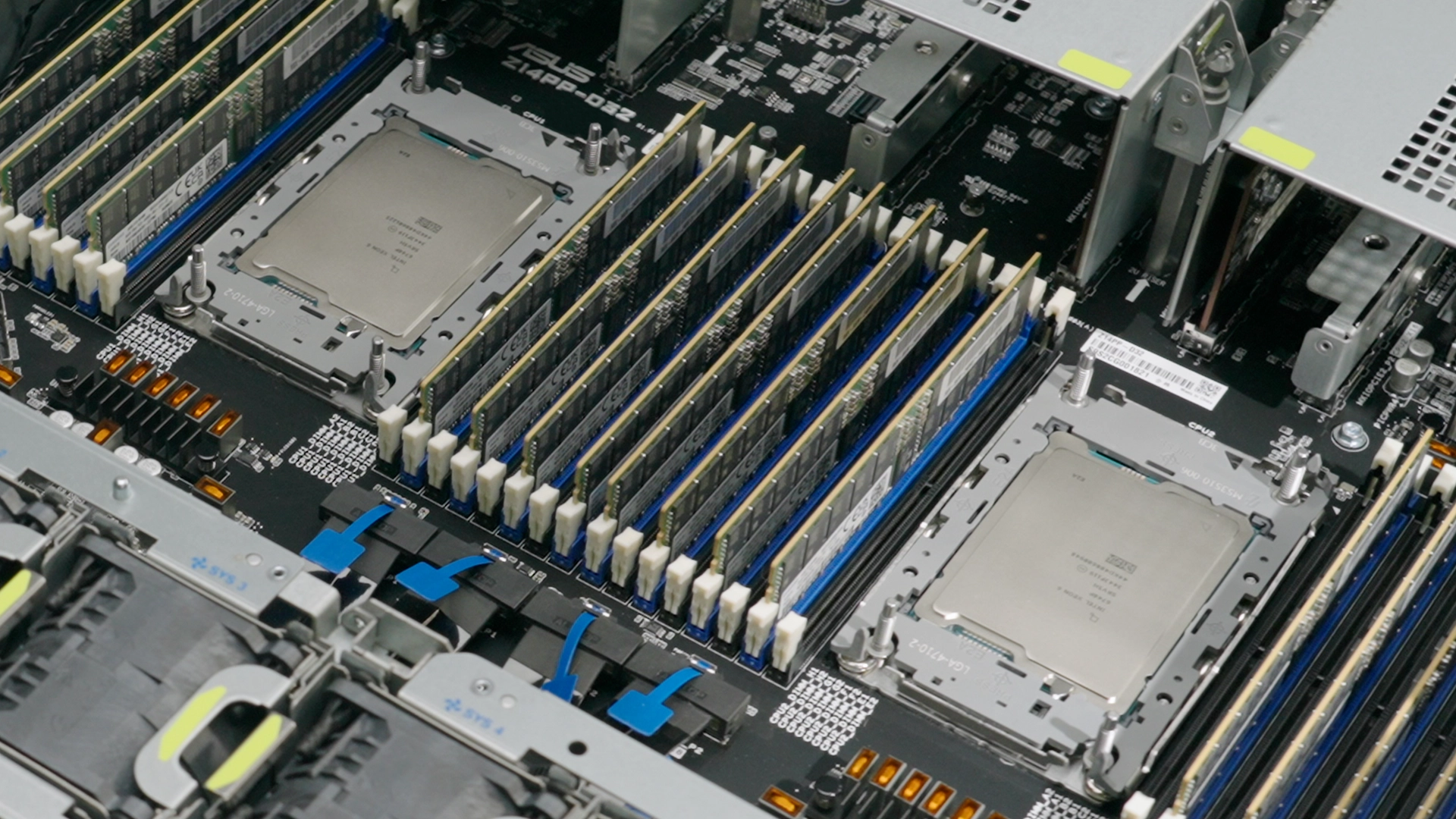
-
High scalable server for multi-tasking
The RS720-E12-RS8G features a three dual-slot GPU-optimized architecture, seamlessly handling demanding graphical and computational workloads while enabling simultaneous process management and high-speed data transfer. Designed for scalability, this versatile server supports a wide range of expansion cards, including networking and RAID, for flexible storage solutions.
-

 1 1 2 3 4 5 6
1 1 2 3 4 5 6110 x Expansion Slots (8 PCIe + 2 OCP3.0) 3x dual-slot GPUs supported
232 x DIMM (Up to 5200 MT/s)
Max up to, MCR DIMM up to 8000MHz(1DPC)38 x 2.5” Tool-less Hot-swap drive bays
41+1 3200W 80 PLUS Titanium PSU
5Dual Intel® Xeon® 6 (Sierra Forest-SP & Granite Rapids-SP) Processors Family, TDP: 350W
66 x 6056 Tool-less hot-swappable Fan Module
-
-

 1 2 3
1 2 31[Bay 1-8] NVMe/SATA*/SAS*
22 x USB3.2 Gen1
3PWR/Location Button & LED
8 NVMe/SATA/SAS*
*SAS support only from optional SAS HBA/RAID card
-
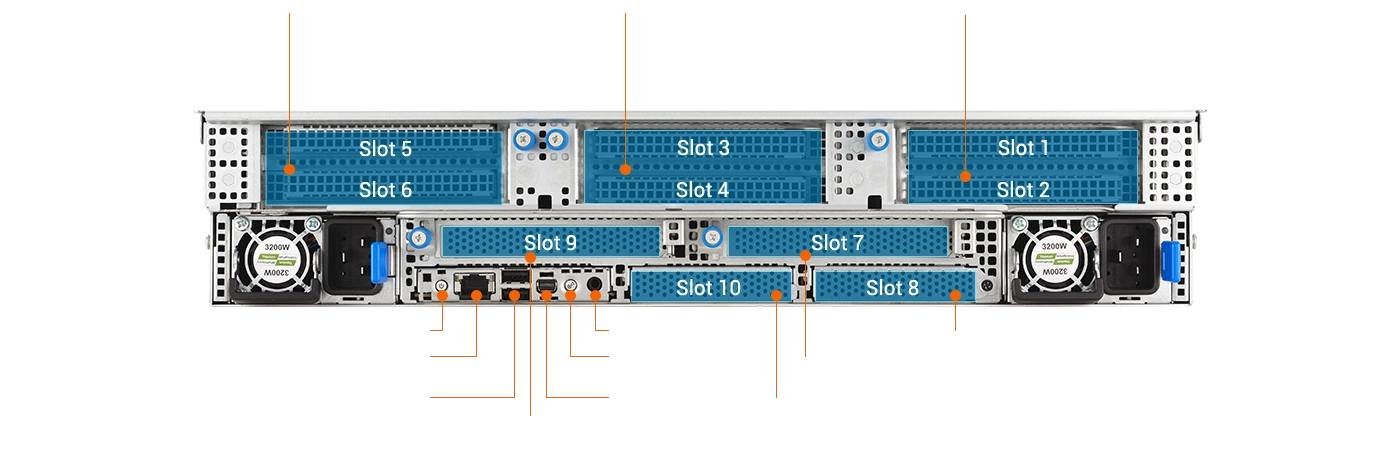
 1 2 3 4 5 6 7 8 9 10 11 12 13
1 2 3 4 5 6 7 8 9 10 11 12 1312 x PCIe Gen5 x 8 (FHFL) or 1 x PCIe Gen5 x16 (FHFL)
22 x PCIe Gen5 x8 (FHFL) or 1 x PCIe Gen5 x16 (FHFL)
32 x PCIe Gen5 x8 (FHFL) or 1 x PCIe Gen5 x16 (FHFL)
4Power switch/LED
5DM LAN port*
62 x USB 5Gbps ports
7PCIe Gen5 x16 (FHHL)
8Mini Display Port
9Location switch/LED
10Debug Port
11OCP3.0 Gen5 x16
12PCIe Gen5 x16 (FHHL)
13OCP3.0 Gen5 x16
*The DM LAN port is for ASUS ASMB12-iKVM controller only.
-
-
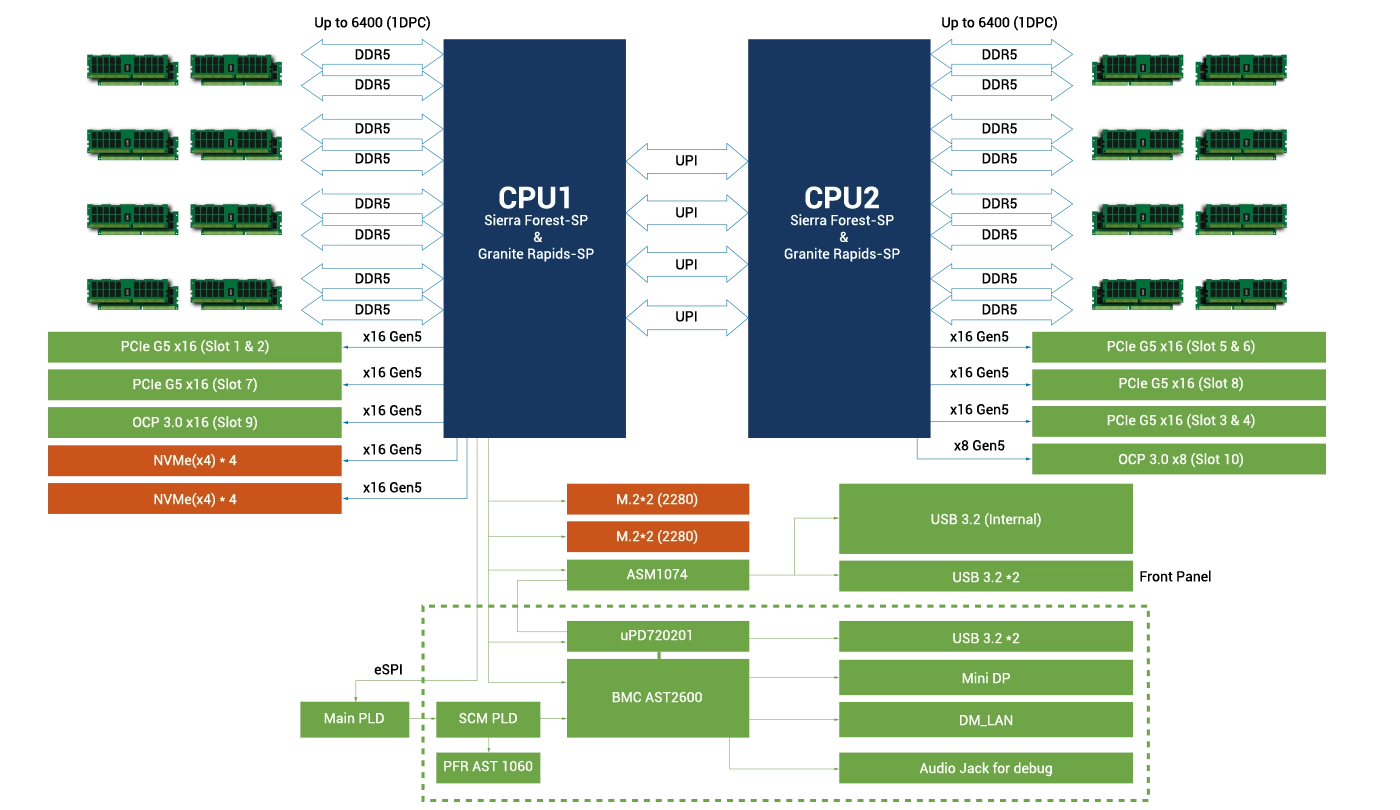
-
-
Scalable modular architecture for seamless integration
RS720-E12-RS8G features a modular DC-MHS architecture that ensures seamless integration and high performance in data center environments. Its scalable design allows businesses to adapt to changing IT workloads by adding or removing modules without disruption. This flexibility improves operational efficiency, simplifies system management and supports phased upgrades. The architecture optimizes capital expenditure and resource use, reducing upfront costs. Additionally, modular components can be replaced or upgraded quickly, minimizing downtime and ensuring continuous operations. The DC-MHS architecture also incorporates advanced cooling and power management systems, improving energy efficiency, reducing operational costs, and supporting sustainability efforts.
-

M-FLW (Modular Hardware System Full Width):
Optimizes server utilization for high-performance computing tasks like AI training and big data analytics.
-
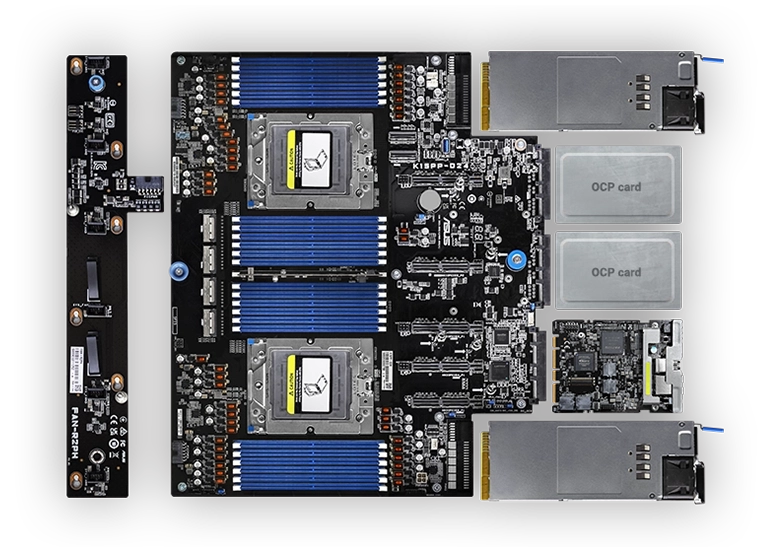
M-PIC (Modular Hardware System Platform Infrastructure Connectivity):
Enables seamless communication and data transfer between different parts of the server, improving overall performance.
-
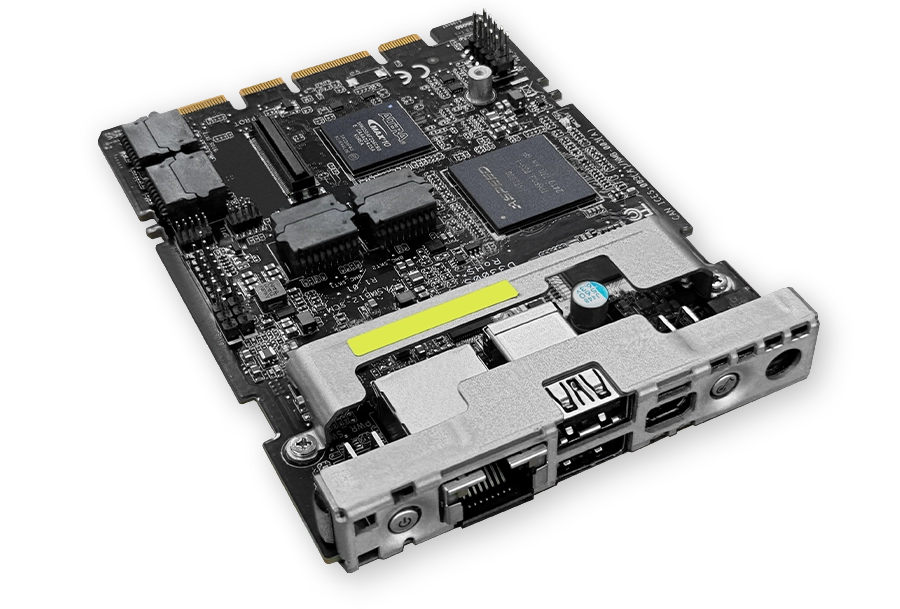
DC-SCM (Data Center Secure Control Module):
Enhances system security by providing a trusted foundation for server operations and remote management.
-
-
Air-cooled solutions for excellent performance
RS720-E12-RS8G features an optimized air-cooled thermal solution with a hot-swap fan bar design and two-sided PSU placement, optimizing airflow, isolating heat sources, and ensuring efficient cooling and reliable performance for demanding applications, supporting up to 350W.
Pausepress the play button to play ESC N8-E11/ESC N8-E11V product video -
Toolless design for fast, simple maintenance
ASUS has redesigned the server-chassis structure for optimal airflow, without compromising on specifications, enhancing cooling efficiency. With a quick-release top cover and a streamlined airflow system, you can manage cables and components effortlessly, reducing maintenance time. This creates a seamless airflow path from front to back, efficiently dissipating heat and keeping the system running cool and stable, streamlining upkeep and minimizing downtime.
-
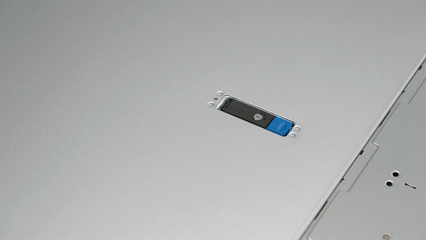
Effortless top-cover design
-
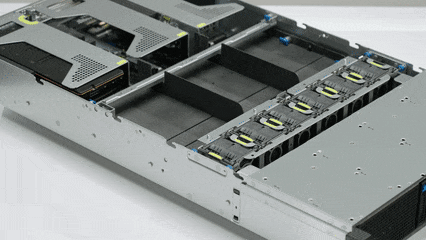
Fan bar design
-
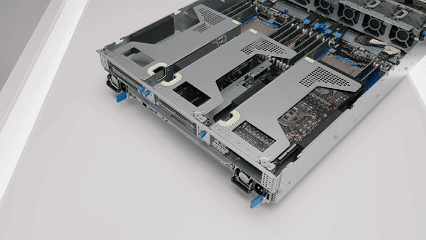
DC-SCM card
-

Air Duct
-
-
World Records Leadership
ASUS holds the most amount of records in dual-socket (2P) and single-socket (1P) on SPEC CPU 2017 benchmark and dominate the computing performance. These top performance results provide a useful insight into compute-intensive workloads on different computer systems, enabling our customers to reduce complexity, tackle challenging workloads and accelerate system validations.
-
ASUS servers feature Performance Boost technology to achieve the best server performance and agility by tuning servers to match the requirements of workloads, letting you gain greater control of your server environment. This technology improves workload throughput by maximizing processor frequency and boost power, ideal for timesensitive applications such as financial services or data center operations.
-

Core Optimizer
Maximizes the processor frequency in multi-core operations, avoiding frequency shifting for reduced latency.
-

Engine Boost
Automatic power acceleration with an innovative voltage design to increase server overall performance.
-

Workload Presets
Preconfigured BIOS server profiles based on workloads and benchmarks for improved performance and efficiency.
* SPEC is a corporation formed to establish and endorse standardized benchmarks and tools to evaluate performance and energy efficiency of computer systems.
-
-
ASUS select servers achieved most power efficiency positions on the SPEC Power benchmark for energy efficiency and demonstrate to customers how they can achieve faster deployments and higher energy efficiency for their IT infrastructure.
-

ASUS Power Balancer
Adjust overall loading automatically based on real-time monitoring to decrease overall power consumption for Improved efficiency and cost/performance optimization.
-

Thermal Radar 2.0
Features intelligent fan-curve adjustments to fit the real-time server usage patterns and lower fan power consumption.
-
-
-
Server-management Solution
-
Remote server management
ASUS ASMB12-iKVM is the latest server-management solution from ASUS, built upon the ASPEED 2600 chipset running on the latest AMI MegaRAC SP-X. The module provides various interfaces to enable out-of-band server management through WebGUI, Intelligent Platform Management Interface (IPMI) and Redfish® API.
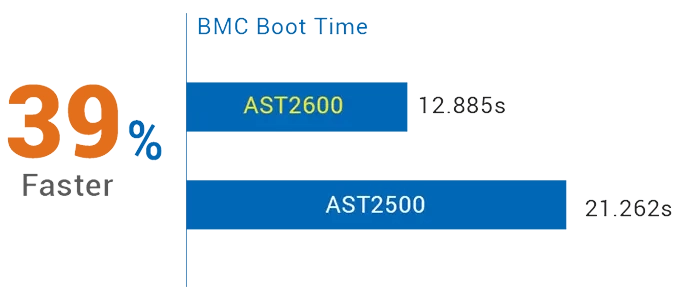
-
Streamline IT operations via a single dashboard
ASUS Control Center (ACC) is remote IT management software designed for monitoring your hardware and software IT assets and inventory status and enabling seamless remote BIOS configurations and updates, efficient IT diagnostics and troubleshooting and enhanced security with Hotfix updates, allowing easier server management for any IT infrastructure.
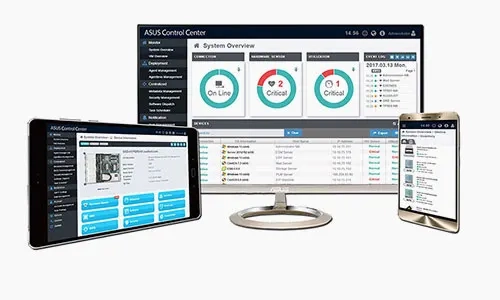
-
-
Enhanced Security
-
Hardware Root-of-Trust Solution:Detect, recover, boot and protect
ASUS servers integrate PFR FPGA as the platform Root-of-Trust solution for firmware resiliency to prevent from hackers from gaining access to infrastructure. ASUS security solutions are fully compliant with the 2018 National Institute of Standards and Technology (NIST) SP 800 193 specification.
* Platform Firmware Resilience (PFR) module must be specified at time of purchase and is factory-fitted. It is not for sale separately.
-
Trusted Platform Module 2.0
ASUS servers also include support Trusted Platform Module 2.0 (TPM 2.0) to secure hardware through integrated cryptographic keys and offer regular firmware update for vulnerabilities.
Learn more about the product support list 〉
-